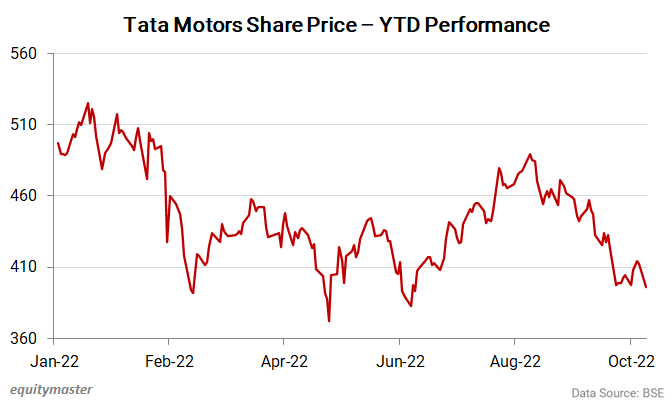Indian Stock Market Update: Tata Motors Faces Challenges Amid Market Surge
Tata Motors Shares Crash After JLR Report | What Went Wrong with Tata Motors?
The Indian stock market kicked off the business week with a bang, surpassing expectations and shrugging off global negative cues. Investors showed strong confidence, pushing the market up by nearly 1% in the opening hours. However, amidst this bullish sentiment, Tata Motors, a prominent automaker, saw its stock take a significant hit, creating a stark contrast in an otherwise upbeat market.

Tata Motors’ Stock Takes a Hit
While the broader market soared, Tata Motors faced intense selling pressure. The company’s stock plummeted by 4%, trading at ₹684 as of the latest update. This decline is part of a broader downward trend, with the stock dropping 5% over the past week, 6% in the last month, and a staggering 13% over six months. Over the course of a year, Tata Motors’ stock has lost 31% of its value, signaling persistent weakness since August 2024.

Why Is Tata Motors Struggling?
The primary trigger for this downturn lies with Jaguar Land Rover (JLR), Tata Motors’ luxury vehicle subsidiary, which contributes 71% of the company’s total revenue and 80% of its profitability. JLR recently issued a weaker-than-expected outlook for the fiscal year 2026, projecting an EBITDA margin of 5-7%, down from 8.5% the previous year. Additionally, JLR’s free cash flow is expected to hover near zero, a sharp decline from the £1.5 billion recorded last year. This suggests potential challenges in profitability and cash reserves, raising concerns among investors.
Despite strong vehicle sales, JLR hasn’t seen significant growth in per-unit revenue, which has remained steady at around £70,000. The management has expressed optimism about recovering to a 10% EBITDA margin and improving free cash flow by fiscal years 2027 and 2028. However, the lack of a clear timeline for this recovery has fueled investor uncertainty, contributing to the ongoing sell-off in Tata Motors’ stock.
A Silver Lining: Positive Rating from Moody’s
Despite the stock’s struggles, Moody’s, a major international rating agency, has offered a glimmer of hope. The agency maintained Tata Motors’ rating at Ba1 with a positive outlook, while upgrading JLR’s rating from Ba2 to Ba1. This decision reflects confidence in Tata Motors’ improving consolidated credit profile, driven by efforts to reduce debt and boost earnings. Key factors supporting this rating include:
- JLR’s strong global brand value in the luxury car segment.
- Tata Motors’ leadership in India’s commercial vehicle and passenger vehicle markets.
- A balanced approach to managing debt and investments.
Moody’s also highlighted the broader Tata Group’s ability to provide financial support during crises, adding a layer of stability to Tata Motors’ outlook.
Strategic Moves: Tata Motors’ Business Restructuring
In a bid to streamline operations, Tata Motors is working on demerging its commercial vehicle business into a separate entity, a process expected to be completed by October 2025. Post-demerger, the new entity will focus exclusively on passenger vehicles and JLR, with the latter likely accounting for over 90% of the new company’s revenue. This shift aims to sharpen Tata Motors’ focus on the passenger and luxury car segments, potentially strengthening its credit profile in the long run.
The Road Ahead for Tata Motors
Tata Motors remains a dominant force in India’s commercial vehicle, passenger vehicle, and electric vehicle markets. However, its performance is heavily tied to JLR, which drives a significant portion of its revenue and profits. While JLR’s weaker financial projections have rattled investors, the positive rating upgrade from Moody’s and the planned business restructuring signal potential for recovery. Investors are advised to tread cautiously, keeping a long-term perspective and consulting with financial advisors before making investment decisions.
Outro
The Indian stock market’s resilience this week showcases the confidence investors have in its growth potential, even as companies like Tata Motors navigate challenges. The automaker’s journey reflects the ups and downs of the market, where opportunities and risks coexist. Stay tuned for more updates as we track the trends shaping India’s financial landscape. What are your thoughts on the market’s performance or Tata Motors’ challenges? Drop a comment below and let’s spark a conversation!
Indian stock market, Tata Motors stock, Jaguar Land Rover, luxury vehicle market, commercial vehicles India, passenger vehicles India, electric vehicles India, stock market trends, financial outlook 2026, EBITDA margin, free cash flow, business demerger, Moody’s rating, Tata Group, investment tips.

